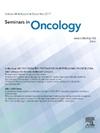Metabolism at the core of melanoma: From bioenergetics to immune escape and beyond
IF 2.5
3区 医学
Q2 ONCOLOGY
引用次数: 0
Abstract
Melanoma is a particularly aggressive type of skin cancer due to its rapid growth and capacity to metastasize. There is substantial metabolic reprogramming in melanoma that is linked to its malignant characteristics, including therapeutic resistance. This review intended to provide a detailed overview of the central metabolic pathways reprogrammed in melanoma, including the Warburg effect and the complex interactions between glycolysis and oxidative phosphorylation, which ultimately influence energy production, biosynthesis, and adaptation to the tumor microenvironment. We also discuss the molecular pathways that regulate these metabolic pathways and the effect these metabolic processes have on crucial elements of melanoma progression, including invasion, metastasis, and survival during nutrient deprivation and hypoxia. Furthermore, we discuss the importance of metabolism beyond glucose, including glutamine metabolism, changes in lipid metabolism, and alterations in one-carbon and nucleotide biosynthesis, as well as mechanisms critical for the proliferation and survival of melanoma cells. An emphasis is placed on the active metabolic crosstalk between melanoma cells and the immune system within the tumor microenvironment, where melanoma cells utilize nutrient competition and the production of immunosuppressive metabolites to alter and block the function of anti-tumor immune cells, thereby facilitating immune evasion and therapy resistance. Lastly, we critically assess developments targeting melanoma metabolism, including pharmacological inhibition of key metabolic enzymes and pathways, as well as metabolic modulation to enhance the efficacy of conventional and immunotherapies. Although promising, this area is complex and subject to contextual effects and metabolic heterogeneity, indicating that we still have a way to go in annotating robust and clinically relevant metabolic targets. We sought to consolidate current knowledge about melanoma metabolism and highlight the challenges, future directions, and complexity of a potential therapeutic vulnerability in the rapidly evolving field of cancer research.
黑色素瘤的核心代谢:从生物能量学到免疫逃逸及其他
黑色素瘤是一种特别具有侵袭性的皮肤癌,因为它的快速生长和转移能力。在黑色素瘤中有大量的代谢重编程,这与它的恶性特征有关,包括治疗耐药性。这篇综述旨在提供黑色素瘤重编程的中心代谢途径的详细概述,包括Warburg效应和糖酵解和氧化磷酸化之间的复杂相互作用,最终影响能量产生、生物合成和对肿瘤微环境的适应。我们还讨论了调节这些代谢途径的分子途径,以及这些代谢过程对黑色素瘤进展的关键因素的影响,包括营养剥夺和缺氧时的侵袭、转移和存活。此外,我们还讨论了葡萄糖以外代谢的重要性,包括谷氨酰胺代谢、脂质代谢的变化、单碳和核苷酸生物合成的改变,以及黑色素瘤细胞增殖和存活的关键机制。重点放在肿瘤微环境中黑色素瘤细胞与免疫系统之间的主动代谢串扰,黑色素瘤细胞利用营养竞争和产生免疫抑制代谢物来改变和阻断抗肿瘤免疫细胞的功能,从而促进免疫逃避和治疗抵抗。最后,我们批判性地评估了针对黑色素瘤代谢的发展,包括关键代谢酶和途径的药理抑制,以及代谢调节,以提高常规和免疫疗法的疗效。尽管前景光明,但这一领域很复杂,容易受到环境效应和代谢异质性的影响,这表明我们在注释稳健且临床相关的代谢靶点方面仍有一段路要走。我们试图巩固目前关于黑色素瘤代谢的知识,并强调在快速发展的癌症研究领域中潜在治疗脆弱性的挑战、未来方向和复杂性。
本文章由计算机程序翻译,如有差异,请以英文原文为准。
求助全文
约1分钟内获得全文
求助全文
来源期刊

Seminars in oncology
医学-肿瘤学
CiteScore
6.60
自引率
0.00%
发文量
58
审稿时长
104 days
期刊介绍:
Seminars in Oncology brings you current, authoritative, and practical reviews of developments in the etiology, diagnosis and management of cancer. Each issue examines topics of clinical importance, with an emphasis on providing both the basic knowledge needed to better understand a topic as well as evidence-based opinions from leaders in the field. Seminars in Oncology also seeks to be a venue for sharing a diversity of opinions including those that might be considered "outside the box". We welcome a healthy and respectful exchange of opinions and urge you to approach us with your insights as well as suggestions of topics that you deem worthy of coverage. By helping the reader understand the basic biology and the therapy of cancer as they learn the nuances from experts, all in a journal that encourages the exchange of ideas we aim to help move the treatment of cancer forward.
 求助内容:
求助内容: 应助结果提醒方式:
应助结果提醒方式:


